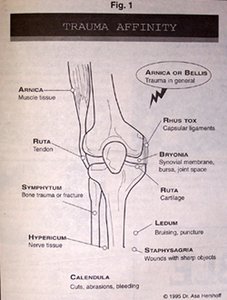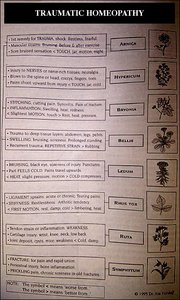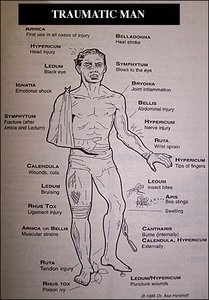From the ancient games of Greece and Asia, to the ballplayers of prehistoric Mayan civilization, to modern day Olympic medallists, the form and style of sports have varied tremendously.
Today, sports medicine is a "growth industry" with over 40,00 team doctors assigned to schools, colleges, and professional teams, and hundreds of sports clinics and centers all over the country. Sports medicine is now a bonafide medical specialty, and is an important part of the practice of many chiropractors today. Yet homeopathy has something unique to offer to the realm of trauma management, while being a natural complement and synergist to chiropractic care.
As a natural, non-toxic form of medicine, homeopathy can effectively reduce typical pain, swelling and inflammation. Beyond this, tissue healing is accelerated to a remarkable degree, without suppressive drugs. Taken before activity, homeopathy acts as a preventive, reducing the effects of overstrain or potential injury. It is also a clinical observation that stamina and performance is enhanced by the use of specific homeopathic remedies. This is a rich area for future scientific study. Like vitamins and other biological supplements, homeopathic remedies, prepared from plants or minerals, enhance physiological functioning in a natural and congruent way.
Exquisitely elegant and and simple in its conception, in its deeper application homeopathy can be incredibly complex and, yes, difficult. Fortunately, for injuries and trauma of the musculoskeletal system, homeopathy provides a straight-forward approach which is easy to learn and apply, yet extremely effective.
Homeopathy uses remedies which stimulate the inherent process of self-healing. The correspondence of a remedy to the internal needs of the body/mind can be arrived at through matching the symptoms of a suffering person with the symptoms produced by a remedy in a healthy person. Symptoms are an accurate language of how the body is attempting to correct itself, and leads to a remedy which matches the internal healing mechanisms already at work. From the point of view of acute injuries and local conditions the symptoms called "modalities" the circumstances which make the condition worse or better are important points to differentiate remedies that seem equally indicated.
There are also other paths that can guide us to the correct homeopathic prescription. Remedies may correspond to the cause of the illness, such as an injury, an emotional shock or an environmental stress, like dampness or extreme heat. The specific location and tissues involved can also strongly influence the selection of a remedy especially where the problem is local, such as in the case of injuries. In chronic disease local problems are often part of an overall chemical and biological imbalance, so that this information is not as persuasive, though still useful. The accompanying anatomical diagram of the knee joint graphically demonstrates the correspondence between remedies and specific types of tissue in the musculoskeletal system.

Though the final choice of remedy must rest on the exact and unique symptoms a person is experiencing, the type of illness (inflammation, spasm, swelling, bruising, etc.) provides a useful therapeutic short-cut in treating acute illness, narrowing our search to a reasonable group of remedies. In the remedy descriptions below, the location (or type of tissue), the pathophysiology (inflammation, weak ligaments, overstrains, etc.), the possible cause (injury, etc.) and subjective symptoms (and modalities) are all part of the cumulative information which leads us to a healing prescription.
Arnica (Leopard's Bane) Arnica montana, a Daisy-like plant growing in the Rocky Mountains, has extraordinary power over the effects of injury. Shock, bruising, swelling, pain„all find rapid relief when Arnica is taken as soon as possible after any type of trauma. If an injury in the past had a serious and lasting negative effect, either locally or on the whole health, Arnica, in a 200 or 1M strength can be used with sometimes dramatic effect, even if the the injury occurred dozens of years before. Arnica is an excellent preventive taken before dental work, surgery, extreme exertion or joint manipulation or mobilization. It is also our best remedy for muscle strains and pulls, in which case it can also be used as an external application in the form of a liquid tincture, gel or ointment. Arnica is also needed for injuries to the eye, ear, and for fears or nightmares after any type of trauma.
Hypericum (St. John's Wort) What Arnica is to muscular strain and trauma in general, Hypericum is to nerve tissue. For blows or falls affecting nerve-rich tissues, such as the head, spine, coccyx or fingertips, this plant has the effect of reducing pain and accelerating the healing of damaged nerves. Like Arnica, Hypericum can be used for injuries in the remote past, such as a shocking blow to the head. In this case, Natrum sulph is also an important remedy to consider, especially if there are alterations in mental capabilities after such an event. Another major effect of Hypericum is the prevention of infection, even tetanus, at the site of a cut or puncture wound. Here it can also be used externally, or as a healing and soothing wash for sunburned skin.
Bellis (Daisy) The Daisy is similar to Arnica in its action, but is appropriate to more chronic or recurrent injuries, or those that have accrued for a long period of time. Thus, in traditional homeopathic literature it was called the "old gardener's remedy". Today we might call it the "old computer user's remedy" an important therapeutic agent for treatment of repetitive strain disorders such as carpel tunnel syndrome, ankle sprains, scalenus anticus syndrome, etc.
Ledum (Labrador Tea) Ledum is well known as a remedy for gout and arthritis. From the perspective of injury and trauma, it is for deep bruising and discoloration. Both Arnica and Bellis have the capability to deal with bruises effectively, but where there is very extensive bruising or hematoma such as with a fracture or black eye, Ledum is unequalled in its ability to rapidly resolve large areas of extravasation.
Rhus tox (Poison Ivy) Though poison ivy is the last thing you want to meet with in the forest, it is the our best therapeutic agent when there are sprained joints or ligaments. Homeopathic pharmaceutical preparation transforms Rhus tox into a totally non-toxic medicine, which has a strong affinity to the entire joint structure. It is excellent after Arnica in any sprain or strain, but also is used extensively for chronic joint problems, including osteoarthritis, due to prolonged wear and tear or living in damp, cold environments.
Ruta (Garden Rue) Ruta is indicated for trauma to tendons, cartilage or periosteum. Its therapeutic effect is directed towards the site of osseous attachment of tendon or ligament. It has a marked predilection to joints where there are complex ligamentous attachments, with a distinct affinity to the wrist, the knee, the low back and the cervical spine, as well as sprains to the shoulder or achilles tendon. It is an important remedy for chronic trauma to the tempero-mandibular cartilage„TMJ syndrome.
Symphytum (Comfrey) Comfrey is a traditional herbal remedy that has the well-earned nickname of "Knit Bone". Homeopathic experience has confirmed the effectiveness of Symphytum for accelerating the healing of fractures in as little as half the time. It is also used for non-union of fractures, and for blows or injuries to the the bony orbit of the eye or the sclera itself.
The chart below gives more detailed symptomatic indications for the selection of the appropriate homeopathic medication.

The last chart demonstrates the remedies needed by the unfortunate "Traumatic Man", which I first developed in 1976 as a teaching device for easily remembering musculoskeletal first aid remedies.

In acute conditions we may use the appropriate remedy in the 30th or 200th strength as often as needed. Ideally, as soon as improvement begins we can reduce the frequency or even stop until improvement ceases, and then resume taking the remedy when symptoms recur. In practice this is not always practical and we may take a remedy according to the following protocol. In very severe injury this may be every 15 minutes or hourly. With improvement or in more chronic situations, a remedy can be taken three times daily, tapering down to once per day. This regimen can be continued for up to several weeks to accomplish complete healing. Remember too that combinations are readily available of these remedies are useful and effective in musculoskeletal conditions, being considerably more efficient of the doctor's and patient's time, cutting down on possible prescribing errors for the novice homeopath.
Whatever other methods of care we may use to assist recuperation, homeopathy should form a part of the healing regimen. A natural complement to successful Chiropractic practice, it is safe, effective, and relies upon our deep inherent resources of biological vitality and intelligence.
Dr. Hershoff is a Chiropractic Physician and Homeopath who has been in private practice for 20 years, currently in Santa Monica, California. The medical consultant for Boericke & Tafel, America's oldest homeopathic pharmacy, he lectures widely and is currently finishing his text entitled Homeopathy: Musculoskeletal Therapeutics.
Dynamic Chiropractic editorial staff members research, investigate and write articles for the publication on an ongoing basis. To contact the Editorial Department or submit an article of your own for consideration, email
.




